
Botrytis cinerea is a necrotrophic fungus that affects many plant species, although its most notable hosts may be wine grapes. In viticulture, it is commonly known as "botrytis bunch rot"; in horticulture, it is usually called "grey mould" or "gray mold".
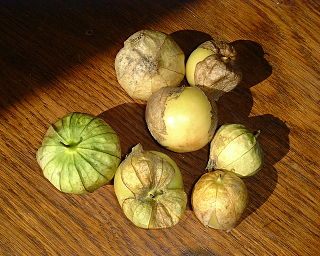
The tomatillo, also known as the Mexican husk tomato, is a plant of the nightshade family bearing small, spherical, and green or green-purple fruit of the same name. Tomatillos originated in Mexico and were cultivated in the pre-Columbian era. A staple of Mexican cuisine, they are eaten raw and cooked in a variety of dishes, particularly salsa verde. The tomatillo is a perennial plant but is generally grown for agriculture each year as if it were an annual.

Physalis is a genus of approximately 75 to 90 flowering plants in the nightshade family (Solanaceae), which are native to the Americas and Australasia. At least 46 species are endemic to Mexico. Cultivated and weedy species have been introduced worldwide. A defining feature of Physalis is a large, papery husk derived from the calyx, which partly or fully encloses the fruit. Many species bear edible fruit, and some species are cultivated.
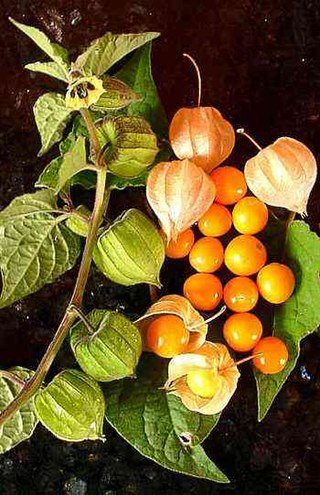
Physalis peruviana is a species of plant in the nightshade family (Solanaceae) native to Chile and Peru. Within that region it is called aguaymanto, uvilla or uchuva, in addition to numerous indigenous and regional names. In English, its common names include Cape gooseberry, goldenberry and Peruvian groundcherry.

Physalis angulata is an erect herbaceous annual plant belonging to the nightshade family Solanaceae. Its leaves are dark green and roughly oval, often with tooth shapes around the edge. The flowers are five-sided and pale yellow; the yellow-orange fruits are borne inside a balloon-like calyx. It is native to the Americas, but is now widely distributed and naturalized in tropical and subtropical regions worldwide.

Tilia americana is a species of tree in the family Malvaceae, native to eastern North America, from southeast Manitoba east to New Brunswick, southwest to northeast Oklahoma, southeast to South Carolina, and west along the Niobrara River to Cherry County, Nebraska. It is the sole representative of its genus in the Western Hemisphere, assuming T. caroliniana is treated as a subspecies or local ecotype of T. americana. Common names include American basswood and American linden.

Frontenac is an interspecific hybrid grapevine that is a result of research and cross-breeding by the University of Minnesota. It was grown from a crossing of the complex interspecific hybrid Landot 4511 and a very cold hardy selection of Vitis riparia. It was released in 1996.

Prunus tomentosa is a species of Prunus native to northern and western China, Korea, Mongolia, and possibly northern India. Common names for Prunus tomentosa include Nanjing cherry, Korean cherry, Manchu cherry, downy cherry, Shanghai cherry, Ando cherry, mountain cherry, Chinese bush cherry, and Chinese dwarf cherry.

Physalis longifolia, known by the common names common groundcherry, longleaf groundcherry, and wild tomatillo, is a species of flowering plant in the nightshade family, Solanaceae. It is native to North America, where it is native to eastern Canada, much of the continental United States, and northern Mexico. It has also been noted as an introduced species in other regions, including parts of the United States outside its native range. In some areas, such as California, it is an occasional noxious weed.
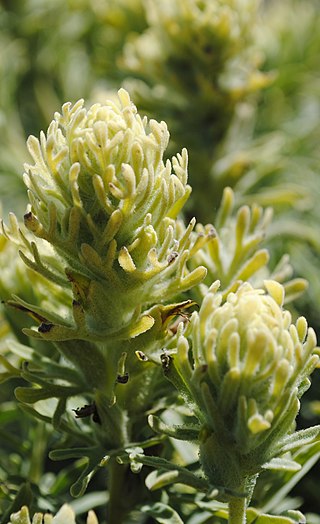
Castilleja grisea is a rare species of Indian paintbrush known by the common name San Clemente Island Indian paintbrush. It is endemic to San Clemente Island, one of the Channel Islands of California. San Clemente Island is owned by the US Navy so the Navy is involved in a management program to recover this species.

Physalis acutifolia is a species of flowering plant in the nightshade family known by the common names sharpleaf groundcherry and Wright's ground-cherry. It is native to the southwestern United States from California to Texas, and northern Mexico, where it can be found in many types of habitat, including disturbed areas. It is sometimes a weed when it springs up in agricultural fields, but it is generally not weedy in wild habitat. This is an annual herb producing a branching stem up to a meter tall. The lance-shaped to oval leaves are up to 12 cm long and have edges lined with shallow, smooth teeth. The herbage is coated thinly in hairs appressed flat against the surface. The flowers growing from the leaf axils are round and flat-faced and sometimes over 2 cm wide. They are white to pale yellow with wide, bright yellow centers. The five stamens are each tipped with an anther about 3 mm long. The star-shaped calyx of sepals at the base of the flower enlarges as the fruit develops, becoming an inflated, ribbed lantern-shaped structure about 2 cm long which contains the berry.
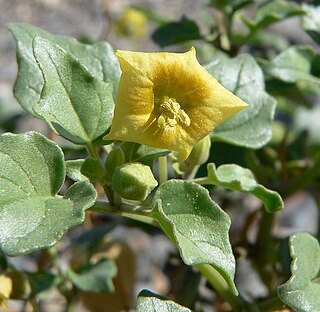
Physalis crassifolia is a species of flowering plant in the nightshade family known by the common names yellow nightshade groundcherry and thick-leaf ground-cherry. It is native to the southwestern United States and northern Mexico, where it can be found in rocky, dry desert and mountain habitat. This is a perennial herb producing a ridged, angular, branching stem approaching 80 cm long, taking a clumped, matted, or erect form. The fleshy oval leaves are 1 to 3 cm long and have smooth, wavy, or bluntly toothed edges. The herbage is glandular and coated in short hairs. The yellow flowers growing from the leaf axils are widely bell-shaped, vaguely five-lobed, and around 2 cm wide. The star-shaped calyx of sepals at the base of the flower enlarges as the fruit develops, becoming an inflated, angled lanternlike structure about 2 cm long, which contains the berry.
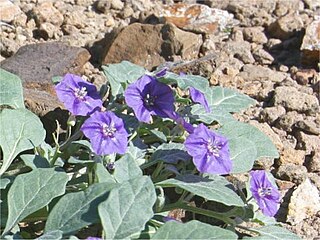
Quincula is a monotypic genus of flowering plants in the nightshade family, Solanaceae. The sole species it contains, Quincula lobata, is commonly known as Chinese lantern, lobed groundcherry, or purple groundcherry.
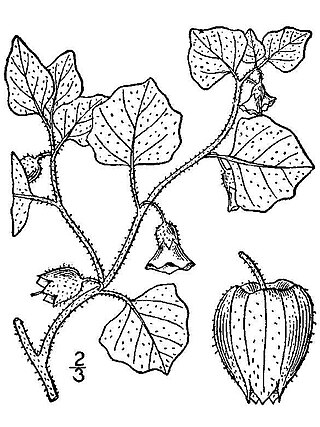
Physalis pubescens is a species of flowering plant in the nightshade family known by many common names, including husk tomato, low ground-cherry and hairy groundcherry in English, and muyaca and capulí in Spanish. It is native to the Americas, including the southern half of the United States, Mexico, Central and much of South America. It can be found elsewhere as an introduced species and sometimes a weed. It can grow in many types of habitat, including disturbed areas. This is an annual herb producing a glandular, densely hairy stem up to about 60 cm (24 in) in maximum height from a taproot. The oval or heart-shaped leaves are 3–9 cm (1.2–3.5 in) long and have smooth or toothed edges. The flowers blooming from the leaf axils are bell-shaped and about a centimeter long. They are yellow with five dark spots in the throats, and have five stamens tipped with blue anthers. The five-lobed calyx of sepals at the base of the flower enlarges as the fruit develops, becoming an inflated, ribbed, lanternlike structure 2–4 cm (0.79–1.57 in) long which contains the berry.

Physalis viscosa is a species of flowering plant in the nightshade family known by many common names, including starhair groundcherry, stellate ground-cherry and grape groundcherry in English, and arrebenta-cavalo, balãozinho, and camambú in Portuguese and Spanish. It is native to South America, and it is known on other continents as an introduced species and sometimes a weed. It can grow in many types of habitat, including disturbed areas.

Physalis virginiana, the Virginia groundcherry, is a rhizomatous perennial with a deeply buried stem base. It is found mostly in eastern North America as far west as Wyoming.

Physalis pruinosa is a plant in the genus Physalis in the nightshade family Solanaceae, often referred to as ground cherry or husk tomato. It is a native species in a range extending from northern Mexico through Central America. The plant has a low, spreading habit, and fruits develop in a papery husk, as is characteristic of the genus. While most parts of the plant are toxic to humans due to the presence of solanine and solanidine, the fruit becomes edible once it has ripened to yellow. The fruit's flavor is similar in some respects to that of a ripe tomatillo, but notably has a strong flavor of pineapple as well, a fact reflected in the name of a common commercial variety, "Cossack Pineapple". The ripe fruit of Physalis pruinosa var. argentinaJ. M. Toledo & Barboza is a food source for the Pilagá ethnic group.
Physalis latiphysa is a herbaceous plant that grows to a height of 30 to 45 cm. The shoot axis is densely hairy with multicellular, glandular trichomes. The leaves are silky and hairy, 5.5 to 16.0 cm long, with petioles 2.5 to 7.5 cm and leaf blades 3.0 to 8.5 cm. The leaf blade has a width of 1.5 to 7.0 cm, the tip is tapering, the base is blunt, rarely skewed by up to 3 mm. The leaf margin is entire or rarely serrated with up to four teeth per side.

Physalis walteri, commonly known as Walter's groundcherry or dune groundcherry, is a species of flowering plant. Its native distribution is Alabama, Florida, Georgia and Virginia in the United States as well as Northeast Mexico. Its habitat is pinelands and open coastal areas.

Alkekengi officinarum, the bladder cherry, Chinese lantern, Japanese-lantern, strawberry groundcherry, or winter cherry, is a species of flowering plant in the nightshade family Solanaceae. It is a close relative of the new world Calliphysalis carpenteri and a somewhat more distant relative to the members of the Physalis genus. This species is native to the regions covering Southern Europe to South Asia and Northeast Asia.


















